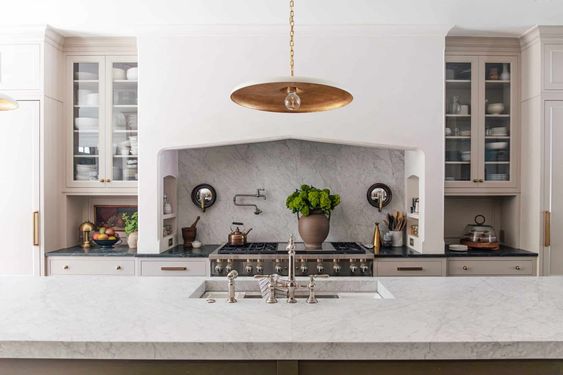Thinking about adding a luxurious style to your kitchen? Marble countertops could be just what you need. This natural stone is loved for its beautiful patterns and colors, making kitchens look luxurious for many years. It’s a great choice if you want your kitchen to look amazing and be practical too. Marble countertops stand out for their beauty and usefulness.

Exploring the Unique Beauty of Marble
Marble is renowned for their stunning aesthetic appeal. Derived from natural stone, each marble slab boasts a unique pattern, creating a truly one-of-a-kind countertop. The variety of shades and colors marble offers is astounding. From the soft, subtle hues of Carrara marble to the dramatic veining of Calacatta, there’s a marble to suit every kitchen style.

Cost of Marble Countertops
When considering marble countertops for your kitchen, it’s essential to understand the cost factors involved. Marble is known for its elegance and beauty, but this luxury comes with a price tag that varies based on several elements:
1. Type of Marble
The type of marble you choose can significantly impact the cost. For example:
- Carrara Marble: This is a more affordable option, often costing between $40 to $100 per square foot. Carrara marble, known for its subtle gray veining, is a popular choice for those seeking elegance on a budget.
- Calacatta Marble: This variety, with its bold veining and dramatic patterns, is typically more expensive, ranging from $100 to $200 per square foot. Calacatta’s striking appearance contributes to its higher cost.
- Statuario Marble: Renowned for its white background and pronounced veining, Statuario can cost between $150 to $250 per square foot, reflecting its rarity and luxury.
2. Slab Thickness
Marble countertops are available in different thicknesses, usually 2 cm or 3 cm. Thicker slabs are more durable and often come with a higher price. Expect to pay about 10-20% more for 3 cm thick marble compared to 2 cm.
3. Fabrication and Installation
The cost of fabricating and installing marble countertops includes cutting, edging, and installing the slabs. This can add between $30 to $100 per square foot to the overall cost, depending on the complexity of the job and the region you are in. Intricate edge profiles or custom cuts will increase the price.
4. Additional Costs
- Edge Treatments: Standard edges are usually included, but more elaborate treatments, such as ogee or bullnose edges, may cost extra.
- Sealing: While some marble comes pre-sealed, you might need to apply an additional sealant to protect the surface, which can add to the initial cost.
- Maintenance: Keep in mind the ongoing maintenance costs. Marble requires regular sealing and special cleaning products, which can contribute to the long-term cost of ownership.
5. Regional Variations
Prices can also vary by location. Marble may be more expensive in areas with limited supply or higher shipping costs. Always get quotes from local suppliers and installers to get an accurate estimate for your area.

Benefits of Marble Countertops
While marble countertops win hearts with their appearance, they’re equally valued for their functionality.
- Aesthetic Elegance: Marble countertops bring unmatched elegance to any kitchen with their unique veining and subtle color variations, elevating the overall design.
- Naturally Cool Surface: Ideal for bakers, marble’s natural coolness helps in rolling out pastry dough, preventing it from sticking and making the process smoother.
- Heat Resistance: Marble’s ability to resist heat allows it to withstand hot pots and pans, making it a practical choice for busy kitchens.
Pros and Cons of Marble
Maintaining the Grandeur: Care Tips for Marble
- Seal Regularly: Apply sealant to your marble countertop annually to protect it from stains.
- Clean Spills Immediately: Wipe up any spills right away, especially acidic ones, to prevent staining and etching.
- Use Cutting Boards: Always cut acidic foods (like tomatoes or lemons) on a cutting board, not directly on the marble.
- Gentle Cleaning: Clean the surface with a soft cloth and mild, pH-neutral cleaner; avoid abrasive or acidic cleaners.
- Use Coasters: Place coasters under glasses, especially those containing alcohol or citrus juices.
- Avoid Heavy Objects: Prevent chips or cracks by not placing or dropping heavy objects on the marble.
Frequently Asked Questions
What types of finishes are available for marble countertops?
Marble countertops typically come in two finishes: honed and polished. Honed finishes offer a matte look, while polished ones provide a glossy, reflective surface.
Can marble countertops withstand the heat?
Yes, marble countertops have excellent heat resistance. However, it’s still best to use a trivet to prevent possible discoloration.
How often should I seal my marble countertops?
Generally, sealing every 6 months to a year is recommended. However, the frequency can depend on the type of marble and the level of use.

Will You Go for Marble?
Choosing to invest in marble countertops is a commitment to timeless elegance and practicality.
Whether it’s the stunning aesthetics or the unique functional benefits, the charm is truly irresistible. By infusing a luxurious appeal into your kitchen, marble offers a return on investment that extends beyond mere monetary value.











